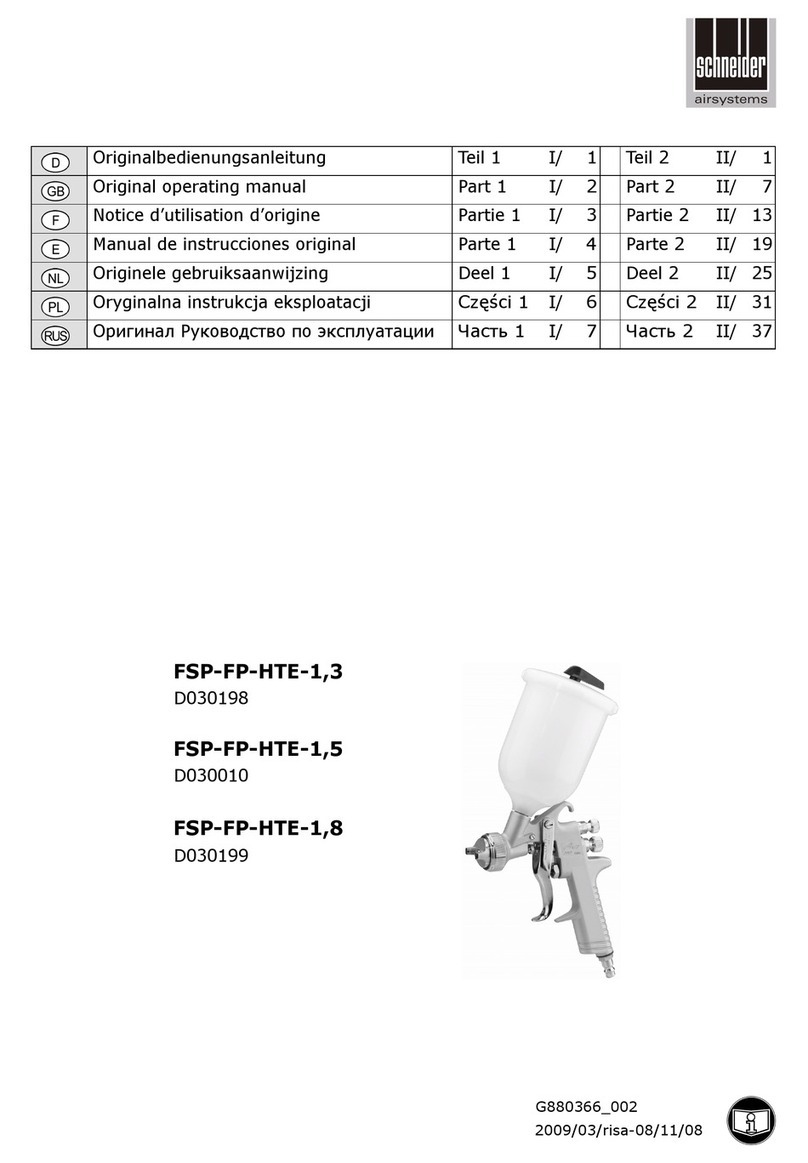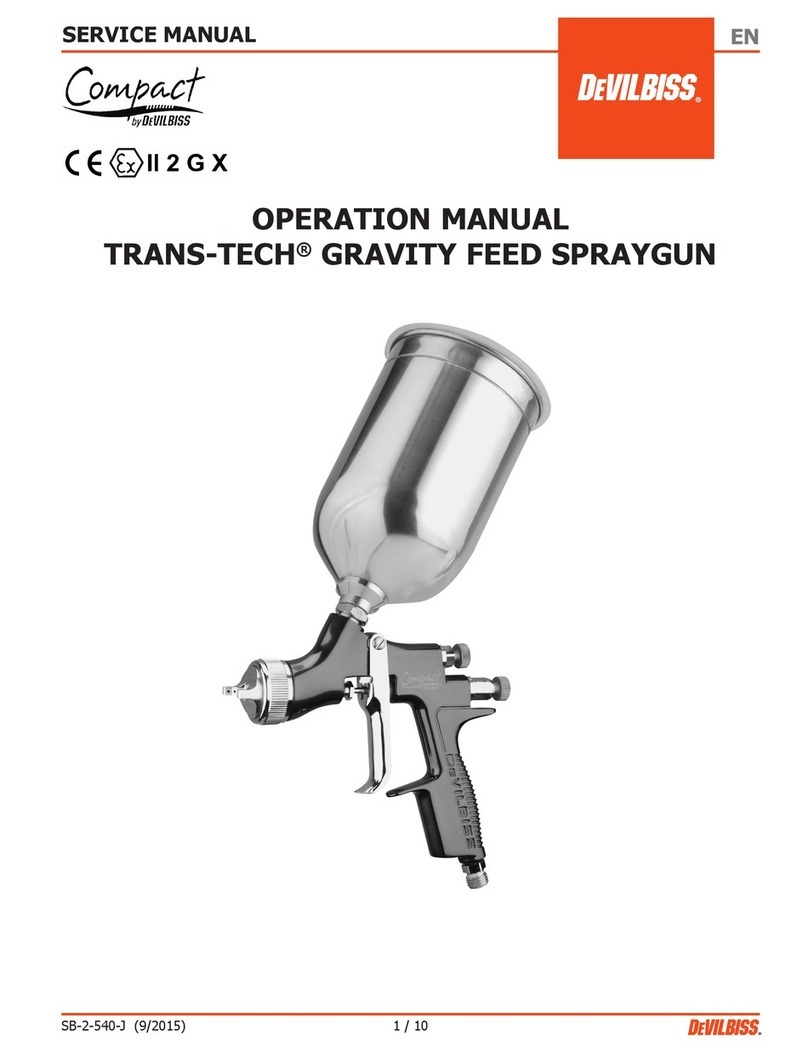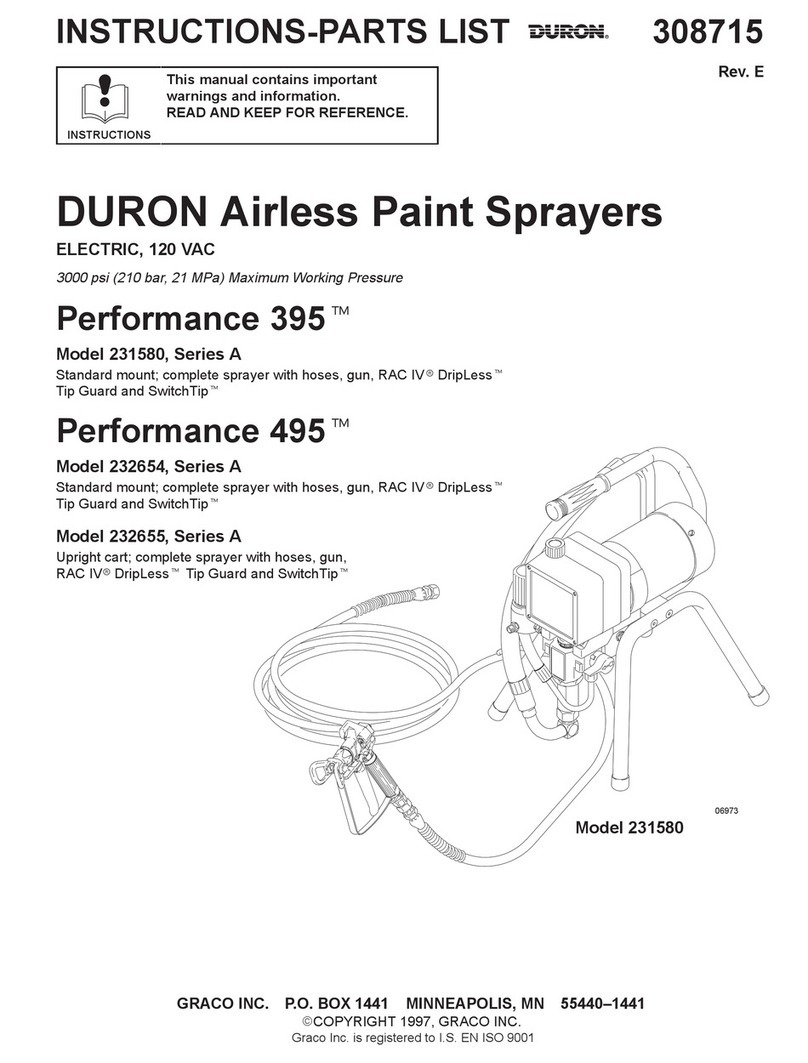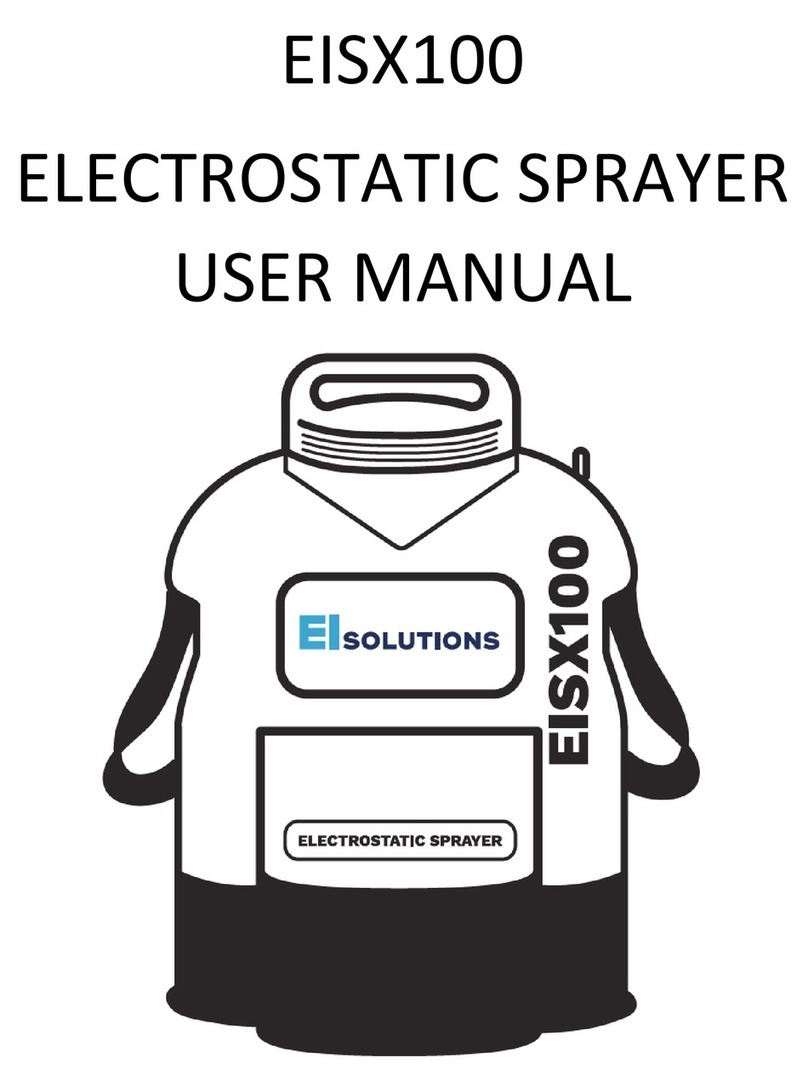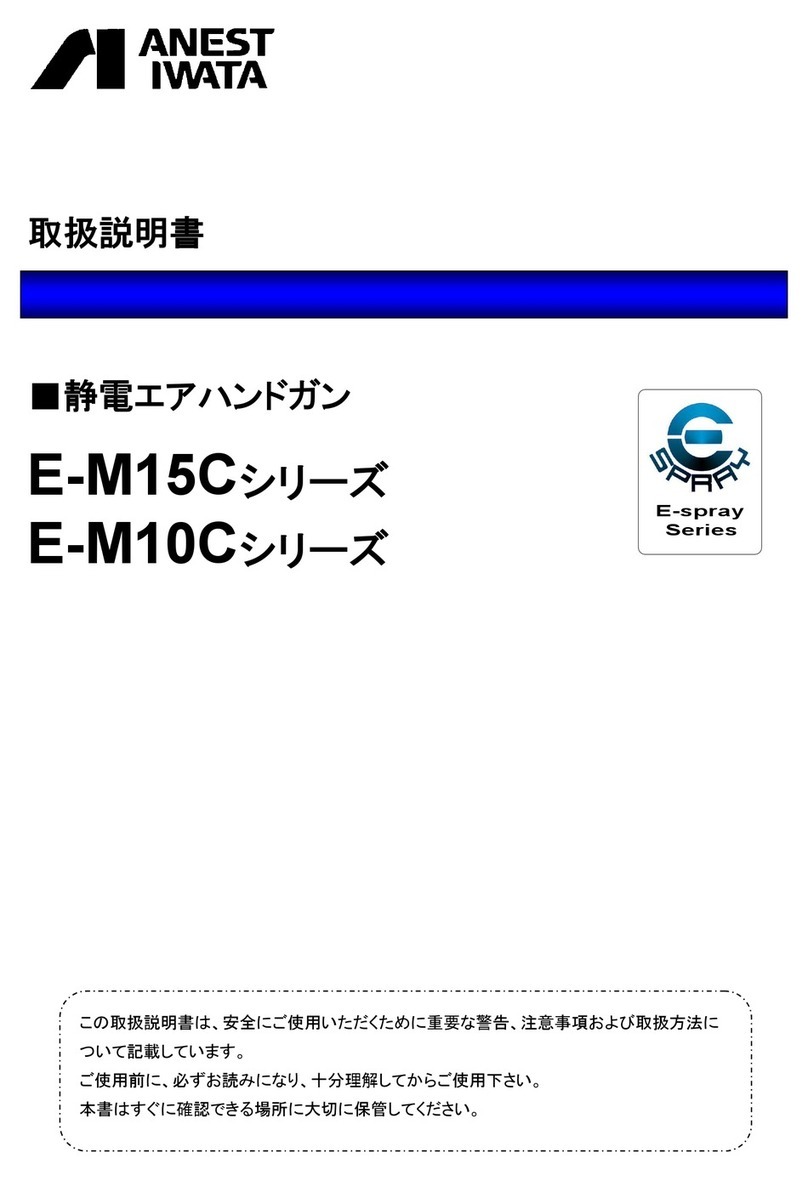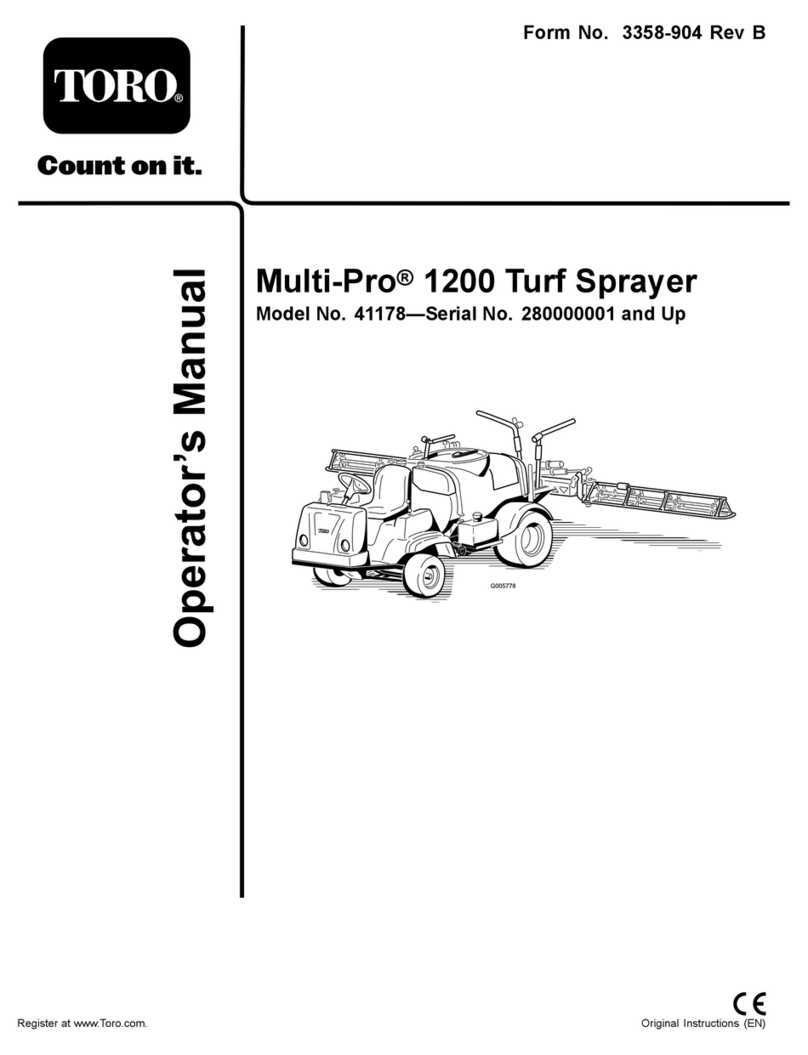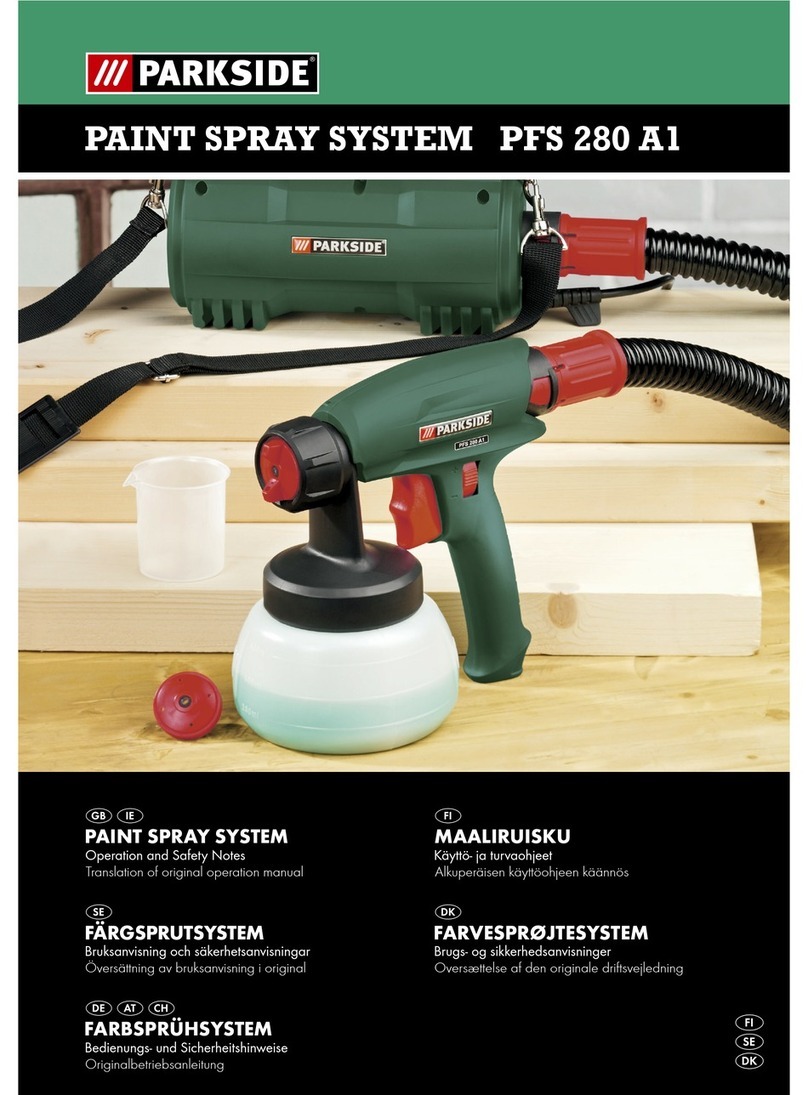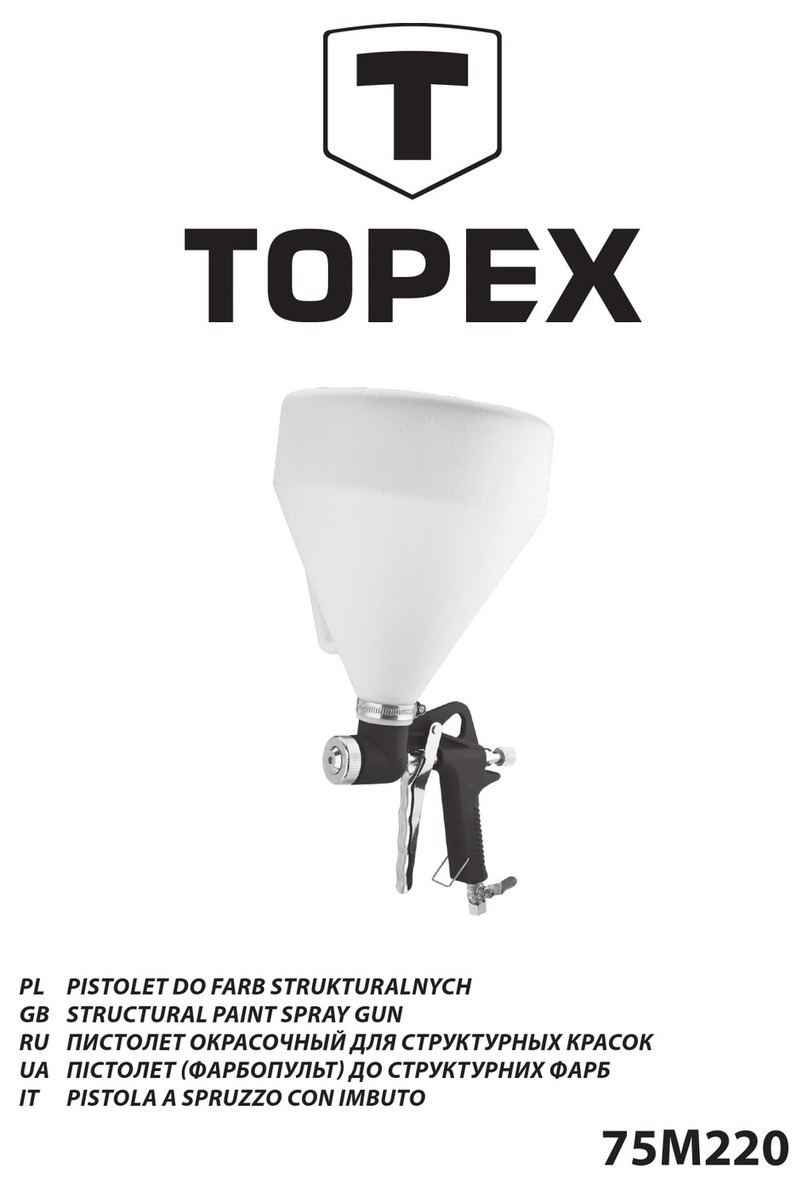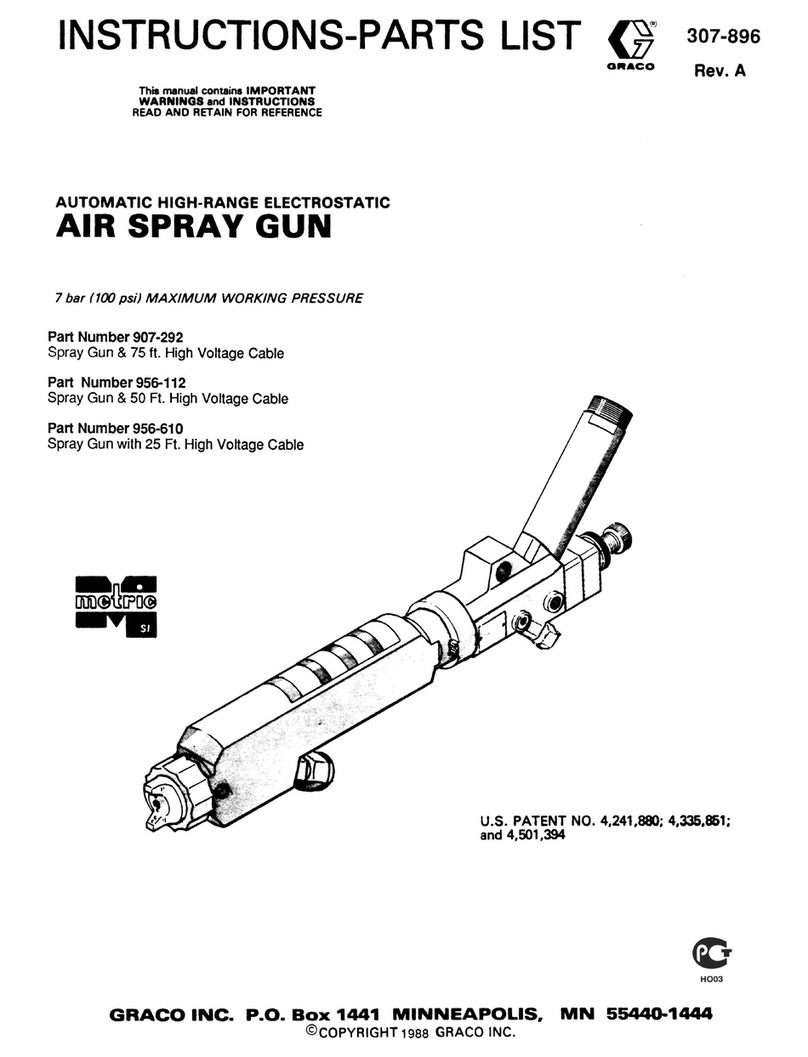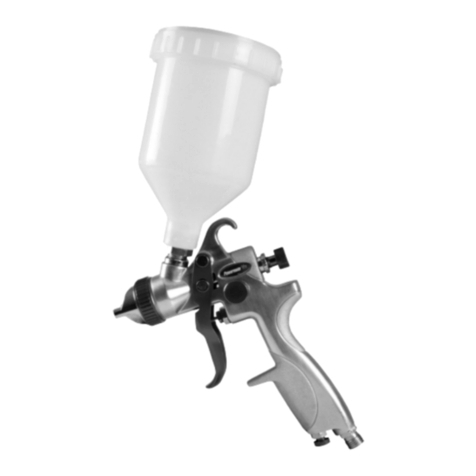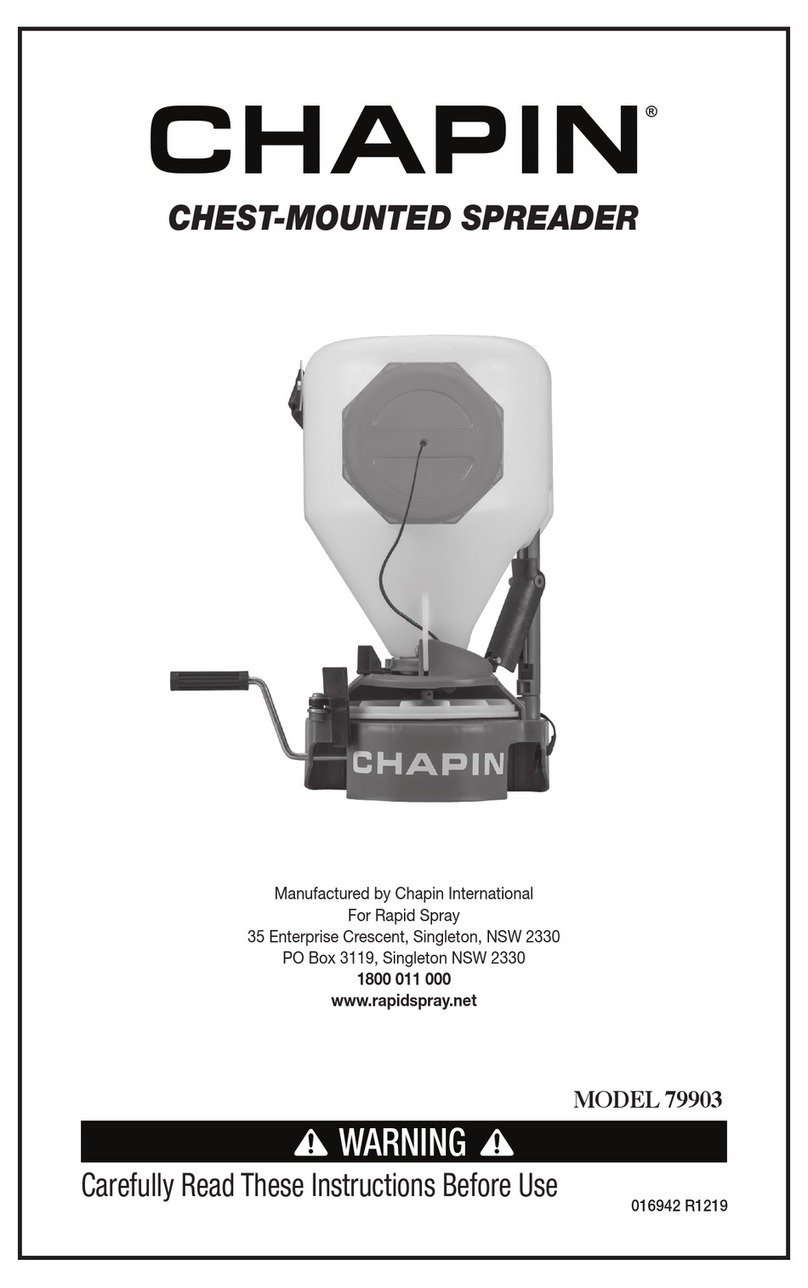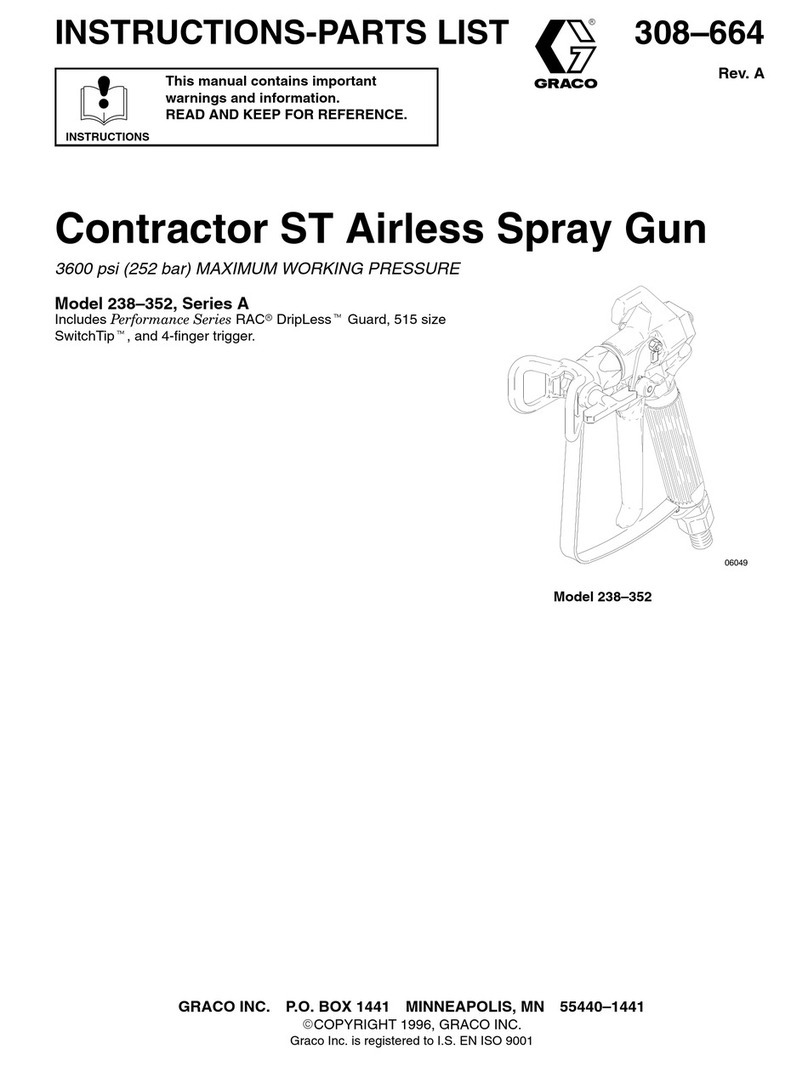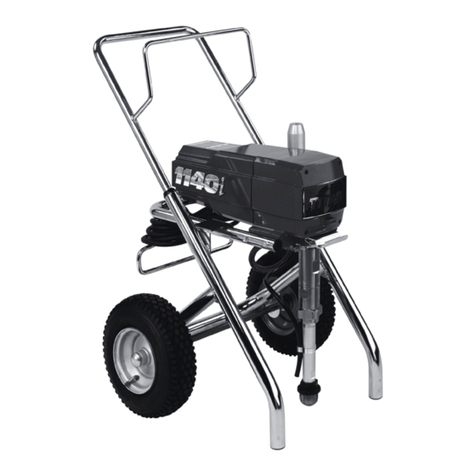Roberts 61-251 User manual

OWNER’S MANUAL
308–021 Rev D
Supersedes
C
CARPET ADHESIVE SPRAYER
1/4 Gallon Per Minute, 120 VAC, 60 Hz
3000 psi (210 bar) Maximum Working Pressure
MODEL
61–251
For
use with non–flammable,
water–base adhesive
Part No. 231–109, Series C
Complete
Sprayer with hose and gun.
U.S.
Patent No. 4,616,982
U.K. Patent No. 2,165,591
Other Foreign Patents Pending
ROBERTS
CONSOLIDATED INDUSTRIES,
INC.
P
.O. BOX 1250/600 N. Baldwin Park Blvd.
City of Industry
, California 91749
This manual contains important
warnings and information.
READ AND RETAIN FOR REFERENCE
Liquids can be injected into the body by high pressure airless
spray
or leaks – especially hose leaks.
Keep
body clear of the nozzle. Never stop leaks with any part of the
body.
Drain
all pressure before removing parts. A
void accidental
triggering
of gun by always setting safety latch
when not spraying.
Never
spray without a tip guard.
In case of accidental skin injection, seek immediate “Surgical
Treatment”.
Failure
to follow this warning can result in amputation or serious
injury.
FIRE
AND
EXPLOSION HAZARD
SKIN INJECTION
HAZARD
READ AND UNDERSTAND ALL LABELS AND INSTRUCTION MANUALS BEFORE USE
Spray
painting, flushing or cleaning equipment with flammable liq
-
uids
in confined areas can result in fire or explosion.
Use
outdoors or
in extremely well ventilated areas. Ground equip
-
ment,
hoses, containers and objects being sprayed.
Avoid all ignition sources such as static electricity from plastic
drop
cloths, open flames such as pilot lights, hot objects such as
cigarettes,
arcs from connecting or disconnecting
power cords or
turning
light switches on and off.
Failure
to follow this warning can result in death or serious injury
.
NOTE:
This is an example of the DANGER label on your sprayer
. This label
is available in other languages, free of charge. See page 15 to order
.

WARNINGS
High Pressure Spray Can Cause Serious Injury
. For Professional Use Only.
Observe All W
arnings. Read and understand all instruction manuals before operating equipment.
FLUID
INJECTION HAZARD
General
Safety
This
equipment generates very high fluid pressure. Spray from
the
gun, leaks or ruptured components can inject fluid through
your skin and into your body , and cause extremely serious
injury,
including the need for
amputation. Also, fluid injected or
splashed
into the eyes or on the skin can cause damage.
Never
point the spray gun at any one or at any part of the body
.
Never put your hand or fingers over the spray tip. Never try to
“blow back” adhesive; this is not an air spray system.
Always
have the tip guard in place on the spray gun when spray
-
ing.
Always follow the Pressure Relief Procedure, below, before
cleaning or removing the spray tip or servicing any system
equipment.
NEVER
try to stop or deflect leaks with your hand or body
.
Be
sure equipment safety devices are operating properly before
each
use.
Medical
Alert––Airless Spray W
ounds
If any fluid appears to penetrate your skin, get emergency
medical care at once. Do not treat as
a simple cut
. T
ell the
doctor exactly what fluid was injected.
Note
to Physician
:
Injection in the skin is a traumatic injury
.
It
is important to treat the injury surgically as soon as possible.
Do not delay treatment to research toxicity . Toxicity is a
concern with some exotic coatings injected directly into the
blood stream. Consultation with a plastic surgeon or re-
constructive
hand surgeon may be advisable
.
Spray
Gun Safety Devices
Be sure all gun safety devices are operating properly before
each
use. Do not remove or modify any part of the gun; this can
cause
a malfunction and result in serious injury
.
Safety Lever
Whenever
you stop spraying, even for a moment, always lock
the
gun safety lever, making the
gun inoperative. Failure to set
the
safety
lever can result in accidental triggering. See the illus
-
tration
below
.
Safety
lever in
unlocked or
spraying
position.
Safety lever in
the locked or
inoperative
position.
TRIGGER
V
iew from front of gun
Diffuser
The gun diffuser breaks up spray and reduces the risk of fluid
injection
when the tip is not installed. Check dif
fuser operation
regularly
. Follow the
Pressure Relief Procedure
, below
, then
remove
the spray tip. Aim the gun into a metal pail, holding the
gun
firmly to the pail. Using the lowest possible pressure, trigger
the gun. If the fluid emitted
is not
diffused into an irregular
stream,
replace the dif
fuser immediately
.
T
ip Guard
Always
have the tip guard in place on the spray
gun while spray
-
ing. The tip guard alerts you to the fluid injection hazard and
helps
reduce, but does not prevent, the risk
of accidentally plac
-
ing
your fingers or any part of
your body close to the spray tip.
Trigger
Guard
Always
have the trigger guard in place on the gun when spray
-
ing to reduce the risk of accidentally triggering the gun if it is
dropped
or bumped.
Spray T
ip Safety
Use extreme caution when cleaning or changing spray tips. If
the
spray tip clogs while spraying, lock the gun safety lever im
-
mediately.
Always follow the
Pressure Relief Procedure,
be
-
low
, and then remove the spray tip to clean it.
Never
wipe of
f build–up around the spray tip
until the pressure
is
fully relieves and the gun safety is locked.
Pressure
Relief Procedure
To reduce the risk of serious injury , including fluid injection,
splashing
fluid or
solvent in the eyes or on the skin, or injury from
moving parts or electric shock, always follow this procedure
whenever
you shut of
f the sprayer
, when
checking or servicing
any
part of the spray system, when installing, cleaning or chang
-
ing
spray tips, and whenever you stop spraying.
1.
Shut of
f the sprayer and unplug it.
2.
Hold a metal part of
the gun firmly to the side of a grounded
metal
pail, and trigger the gun into the adhesive pail to
relieve
pressure.
3.
Lock the gun safety lever
.
4. Turn
the bypass valve
ONE turn
counterclockwise
to drain
adhesive
back into the pail.
If
you suspect that the spray tip or hose
is completely clogged,
or that pressure has not been fully relieved after following the
steps above,
very slowly loosen the part to relieve pressure
gradually,
then loosen completely
. Now clear the tip or hose.

EQUIPMENT MISUSE HAZARD
General
Safety
Misuse of the spray equipment or accessories, such as over
pressurizing, modifying parts, using incompatible chemicals
and
fluids, or using worn or damaged parts, can cause them to
rupture and result in fluid injection, splashing in the eyes or the
skin,
or other injury, or fire, explosion or property damage.
Never
alter or modify any part of this equipment; doing so
could
cause
it to malfunction.
Check
all spray equipment regularly and repair or replace worn
or
damaged parts immediately
.
Always
wear protective eyewear
, gloves, clothing and respira
-
tor
as recommended by the fluid and solvent manufacturer
.
System
Pressure
This
sprayer can develop 3000 psi (210 bar)
Maximum Working
Pressure.
Be sure all spray equipment and accessories used
are rated to withstand the this pressure. Do not exceed the
maximum working pressure of any component or accessory
used
in the system.
Fluid and Solvent Compatibility
All chemicals used in the sprayer are chemically compatible
with
the wetted parts shown in the
T
echnical Data
on the back
cover. Always read the chemical manufacturer’s literature be-
fore
using them in this sprayer
.
Hazard of Using Fluids Containing Halogenated
Hydrocarbons
Never use 1,1, 1–trichloroethane, methylene chloride, other
halogenated hydrocarbon solvents or fluids containing such
solvents
in this equipment. Such use could result
in a chemical
reaction, with the possibility of explosion, which could cause
death,
serious injury and/or substantial property damage.
Consult
your fluid suppliers to ensure that the fluids being used
are
compatible with aluminum and zinc parts.
FIRE
OR EXPLOSION
HAZARD
Static
electricity is created by the flow of fluid through the pump
and hose. If every part of the spray equipment is not properly
grounded, sparking may occur , and the system may become
hazardous. Sparking may also occur when plugging in or un-
plugging a power supply cord or using a gasoline engine.
Sparks can ignite fumes from solvents and the fluid being
sprayed, dust particles and other flammable substances,
whether you are spraying indoors or outdoors, and can cause
a fire or explosion and serious injury and property damage.
If you experience any static sparking or even a slight shock
while using this equipment, stop spraying immediately .
Check the entire system for proper grounding. Do not use the
system again until the problem has been identified and cor-
rected.
Grounding
To
reduce the risk of static sparking, ground the sprayer and
all
other
spray equipment used or located
in the spray area. Check
your
local electrical code for detailed grounding instructions for
your area and type of equipment. Be sure to ground all of this
spray
equipment:
1.
Sprayer:
plug
the power supply
cord, or extension cord, each
equipped
with an undamaged three-prong plug, into a prop
-
erly grounded outlet. Do not use an adapter. All extensions
cords
must have three wires and be rated for 15 amps.
2.
Fluid hoses:
use only grounded hoses with a maximum f
500 ft (150 m) combined hose length to ensure grounding
continuity.
See
Hose Grounding Continuity below.
3.
Spray gun:
obtain grounding through connection to a prop-
erly
grounded fluid hose and sprayer
.
4.
Object being sprayed:
according to local code.
5.
Fluid supply container:
according to local code.
6.
All
solvent pails used when flushing,
according to local code.
Use
only metal pails, which are conductive. Do not place the
pail on a non–conductive surface, such as paper or card-
board,
which interrupts the grounding continuity
.
7.
To maintain grounding continuity when flushing or relieving
pressure
,
always hold a metal part of the gun firmly to the side
of
a grounded metal pail, then trigger the gun.
Flushing
Safety
Reduce the risk of fluid injection injury , static sparking, or
splashing
by following the flushing procedure given on page 7
of
this manual. Follow the
Pressure Relief Procedure
on page
2, and remove the spray tip before flushing. Hold a metal part
of
the gun firmly to the side of
a grounded metal pail and use the
lowest
possible fluid pressure during flushing.
HOSE SAFETY
High
pressure fluid in the hoses can
be very dangerous. If the
hose develops a leak, split or rupture due to any kind of wear,
damage
or misuse, the high pressure spray emitted from it
can
cause
a fluid injection injury or other serious
injury or property
damage.
All fluid hoses must have strain reliefs on both ends!
The
strain reliefs help protect the hose from kinks or bends at or
close
to the coupling which can result in hose rupture.
Tighten all fluid connections securely before each use. High
pressure
fluid can dislodge a loose coupling or allow high pres
-
sure
spray to be emitted from the coupling.
Never
use a damaged hose. Before
each use, check the entire
hose for cuts, leaks, abrasion, bulging cover , or damage or
movement
of the hose couplings. If
any of these conditions ex
-
ist, replace the hose immediately. Do noT try to recouple high
pressure hose or mend it with tape or any other device. A re-
paired
hose cannot contain the high pressure fluid.
Handle
and route hoses carefully
. Do not pull on hoses to move
equipment.
Keep hoses clear of moving parts and hot
surfaces
of
the pump and gas engine. Do not use fluids or solvents which
are not compatible with
the inner tube and cover of the hose. Do
not
expose
Graco hoses to temperatures above 180
F (82
C)
or
below –40
F (–40
C).
Hose Grounding Continuity
Proper
hose grounding continuity is essential to maintaining a
grounded
spray system. Check the electrical resistance of your
fluid
hoses at least once a week. If your hose does not have a
tag on it which specifies the maximum electrical resistance,
contact
the hose supplier or manufacturer for the maximum re
-
sistance
limits. Use a resistance meter in the appropriate range
for your hose to check the resistance. If the resistance exceeds
the recommended limits, replace it immediately . An un-
grounded
or poorly grounded hose can make
your system haz
-
ardous.
Also read
FIRE OR EXPLOSION HAZARD, above.
IMPORTANT
United
States Government safety standards have been adopted under the Occupational Safety and
Health Act. These standards –
particularly
the General Standards, Part 1910, and the Construction Standards, Part 1926 – should be consulted.

Setup
1. Prepare the adhesive.
This is probably the most important step
toward trouble-free spraying!
Prepare the adhesive according to the manufactur
-
er’
s recommendations. Remove any skin that may
have formed on the top of the coating. If neces
-
sary
, thin the coating.
2. Install a spray tip and the tip guard on the spray
gun.
Place the tip washer between the
gun outlet and
the
extension tube.
3. Screw the gun tightly on the hose. Connect the
other
end of the hose to the 1/4 npsm(m) outlet nipple
of
the sprayer
.
4.
Check the hydraulic oil level.
Unscrew the fill cap
(5).
The oil should be 1 inch (25 mm) from the top of
the
plate.
If it is not, fill as necessary with lightweight
hydraulic
oil; use only Graco Hydraulic Oil, Part No.
218–797. Install the fill cap. See Fig. 1.
5. Check the electrical service. It must be 120 VAC,
60
Hz, 15 Amp (minimum). Be sure the electrical
out
-
let
is properly grounded.
Y
ou can use up to 100 foot (30 m) of 3 wire, 14
gauge (minimum) extension cord. Longer exten
-
sion cords may af
fect the sprayer performance.
Use more spray hose, not longer extension cords.
Do not remove the third (grounding) prong of the
plug, and do not use an adapter
.
6. Plug in the sprayer . First be sure the ON/OFF
switch (11) is OFF and the pressure control (4) is
turned
fully
counterclockwise
. Plug the sprayer into
a
grounded outlet that is at least 20 foot (6 m) away
from
the spray area to reduce the chance of a spark
igniting
spray vapors or dust particles.
Fig. 1
1
inch
(25 mm)
0269
5
Fig.
2
0270
11
4
1
2
Decrease
pressure (counterclockwise).
Increase
pressure (clockwise).
2
1

Startup
CAUTION
The
wallet sized warning card provided with the gun
should
be kept with the operator at all times. The
card
contains important information on reducing the risk of
a fluid injection injury , and treatment information
should an injection injury occur. Additional copies of
this
card are available at no cost.
CAUTION
Never start the electric motor with the inlet valve
removed,
as it will severely damage the diaphragm.
NOTE: If the sprayer has been started before, be sure
the pressure has been relieved or the sprayer will not
start.
1. Open the bypass valve (66) ONE turn counter-
clockwise.
Do not place the pump intake in the
pail
yet.
See Fig. 3.
2. Turn the pressure control fully (4) clockwise to in-
crease
pressure. See Fig. 3.
3. Remove the inlet strainer (27) and place your hand
over the inlet valve. Start the sprayer and confirm
that
it is drawing a vacuum.
NOTE: If the inlet valve (26) is not drawing a vacuum,
turn
the sprayer OFF
. T
urn the sprayer over
. Press down
on the stem (A) inside the inlet
valve lightly with a small
screwdriver,
and pour about a teaspoon of mineral spirits
or solvent into the valve. See Fig. 4. Release the valve
and
turn the sprayer upright. With the pressure turned
up,
turn
on the sprayer
. This should free any
sticking parts in
the pump. Now check again for a vacuum. Shut of f the
sprayer
and install the inlet strainer (27).
4. Place the adhesive pump assembly into a properly
prepared
5 gallon pail of adhesive.
5. Turn
the sprayer ON and allow the
adhesive to circu
-
late
through the bypass valve (4) for one or two min
-
utes.
NOTE: If the adhesive does not circulate back into the
pail, turn down the pressure and turn the motor on and
off
several times to help prime the sprayer
.
6. Turn the bypass valve (66) clockwise (finger tight)
to
close it; this allows the pump to build up pressure.
7. Release
the trigger safety lever
. T
rigger the gun onto
a piece of paper to check the spray pattern. The
spray
pattern
should be 12 to 18 inches wide with the
tip
held 12 inches from the surface. Start at the low
-
est pressure setting and then increase the pressure
until
you get the recommended spray fan width. T
oo
much pressure creates an unacceptable “fogging”
pattern.
8. Whenever
you stop spraying, always set the trigger
safety lever to prevent accidentally triggering the
gun.
9. Whenever you stop spraying for more than a mo-
ment,
and when the sprayer is unattended, shut it of
f
and
follow the
Pressure Relief Procedure
on page
2.
10. If the tip clogs, engage the trigger safety lever, shut
off and unplug the sprayer , and open the bypass
valve
one turn
counterclockwise
. Disassemble the
tip in the reverse order of assembly (see manual
307–821). Thoroughly clean all parts in a warm,
soapy water and inspect for wear or damage. Re-
place parts as needed and reassemble. Be sure to
use
a new seal and gasket when changing tips.
11. Important maintenance procedures are given on
pages
6 and 7.
Fig. 3
Fig. 4
0271
0272
27
66
4
1
3
4
2
Decrease
pressure
(counterclockwise).
Increase pressure (clockwise).
Open (counterclockwise).
Close (clockwise).
1
3
4
2
22
26
A

Maintenance
CAUTION
Thorough flushing and proper maintenance are
essential to keep the sprayer working properly
and
avoid costly damage to the sprayer or the ob
-
ject being sprayed.
Diaphragm Failure: Always replace the diaphragm
after
every 500 hours
of operation (once every 4 to 6
months).
The diaphragm weakens with use. If it rup
-
tures,
hydraulic oil and adhesive may mix, damaging
the sprayer and/or the surface of the object being
sprayed
may be damaged.
Follow the Maintenance Intervals outlined below
.
CAUTION
Failure
to properly tighten the inlet valve and
screws
at
the intervals indicated will result in oil leaking from
the hydraulic system into the adhesive, and can
cause
costly damage to the sprayer
.
Maintenance Intervals
Flushing Immediately
after each use.
Lubricate the intake valve.
Immediately after each use.
Tighten the fluid pump
screws
and the inlet valve.
1.
After
the first 3 to 5 hours of
operation.
2. After the next 3 to 5 hours
of
operation.
3. Each 25 hours thereafter
(about weekly).
Check
or
change the hydrau
-
lic
oil.
1. Check the oil after each
use
of the sprayer
.
2.
Change the oil after the first
20
hours of operation.
3. Change the oil each 50
hours
thereafter (about twice
monthly).
Replace the diaphragm.
After every 500 gallons of
fluid
sprayed (4
to 6 months).
Tighten
the Fluid Pump Screws and Inlet V
alve
See Fig. 5.
1. Follow
the
Pressure Relief Procedure
on page 1
1.
2. Torque the four screws (25) on the fluid pump to
170–200
in–lb (19–23 N.m).
3. Torque the inlet valve (26) to 320–360 in–lb (36–41
N.m).
Fig.
5
0273
1
3
2
Lubricate
the threads.
T
orque to 170–200 in–lb (19–23 N.m)
T
orque to 320–360 in–lb (36–41 N.m)
22
26
25
12
1 3
Lubricate the Inlet V
alve.
See Fig. 6.
1. Follow
the
Pressure Relief Procedure
on page 1
1.
Remove
the inlet screen.
2. Turn
the sprayer over
. Press down lightly on the stem
of
the inlet valve with a small screwdriver
. Pour about
a
teaspoon of mineral spirits or solvent
into the valve,
then
remove the screwdriver
.
3. Set the sprayer upright. Increase the pressure con-
trol
setting half way
. T
urn on the
sprayer for a few se
-
conds,
then turn it OFF
.
4. Now tighten the fluid pump screws and the inlet
valve.
Fig.
6
0272
22
26
A

Check and/or Change the Hydraulic Oil
See Fig. 7.
1.
Follow the
Pressure Relief Procedure
on page 2.
2. Remove
the fill cap. The oil should be 1 inch (25 mm)
from
the top of the plate. If it is lower
, add oil as nec
-
essary.
use only Graco lightweight hydraulic oil, part
no. 218–797. Reinstall the fill cap, hand tight, if you
are
not going to change the oil.
3. To
change the oil, turn the sprayer over and drain the
oil
through the fill cap hole.
CAUTION
Whenever
you remove the fill cap, be very careful not
to let any dirt, adhesive particles, or other contami-
nants get into the hydraulic system. Contaminants
can
cause damage to the hydraulic system.
4. Fill
the hydraulic pump housing with
16.5 ounces (55
ml) of Graco lightweight hydraulic oil.
Reinstall the fill
cap.
5. Plug in the sprayer . Turn the pressure control fully
counterclockwise (no pressure). T urn on the
sprayer
and let it run for two minutes to fill the hydrau
-
lic system. Increase the pressure to maximum and
turn
the sprayer on and of
f four times to help rid the
hydraulic system of air
.
Flushing Procedure
1. Shut off the sprayer. Lock the gun trigger safety le-
ver.
Open the bypass valve ONE turn
counterclock-
wise. Raise the fluid pump just above the adhesive
and turn on the sprayer to drain the adhesive. Now
turn
of
f the sprayer
. See Fig. 8.
2.
Place the fluid pump in a grounded pail of solvent.
3. Check to be sure the trigger safety lever is locked.
Remove
the spray tip from the gun.
Unlock the safety
lever. Hold a metal part of the gun firmly to the side
of a grounded metal pail. Close the bypass valve.
Trigger the gun into the pail. T urn on the sprayer .
Watch
the side of the pail for solvent to appear
. Then
release
the gun trigger
. T
urn of
f the sprayer
.
4. With
the bypass valve (66) closed, turn on the spray
-
er,
trigger the gun into the flushing pail and allow the
solvent
to circulate through the hose and gun for two
to
three minutes, using the lowest possible
pressure.
See
Fig.
8. Release the gun trigger and lock the safe
-
ty
lever
. T
urn of
f the sprayer
.
5. Open the bypass valve (66) ONE turn counter-
clockwise.
6. Raise the fluid pump above the solvent, turn on the
sprayer,
and allow the pump to run itself dry
. T
urn the
sprayer OFF.
7. Using
a
clean pail of water or solvent, and the lowest
possible
pressure, flush again to be sure all
adhesive
particles
are removed.
8.
Remove the fluid strainer and clean it thoroughly
.
9.
Now lubricate the inlet valve. See page 6.
Fig. 7
1
inch
(25 mm)
0269
5
Fig.
8
0275
0270
1
3
4
2
Decrease
pressure
(counterclockwise).
Increase pressure (clockwise).
Open (counterclockwise).
Close (clockwise).
66
41
3
4
2
11
Fig.
9
0276
ÄÄ
ÄÄ
ÄÄ
ÄÄ
Maintain
firm metal–
to–metal contact
between
gun and con
-
tainer
1
1

Troubleshooting
WARNING
To
reduce the risk of
serious injury
, including fluid in
-
jection, always follow the Pressure Relief Proce-
dure Warning on page 2 before checking or repair-
ing
any part of the spray system.
NOTE: Repairs, other than those for which instructions
are
given
on page 10, should be performed by a trained
and
qualified repair agency
.
NOTE:
If your sprayer is not operating well, or will not op
-
erate at all, check for obvious problems first. Follow the
Startup procedure exactly (see page 5). Then if the
sprayer won’t start, use the T roubleshooting Chart for
help
in identifying the possible cause.
NOTE:
Remember
, taking the time after each use of the
sprayer to perform all of the maintenance procedures
given on page 6 and 7 will help prevent down time and
costly
repair bills.
PROBLEM CAUSE SOLUTION
“Fogging” spray pattern
T
oo much pressure.
T
urn the pressure down.
Spray gun won’t shut of
f W
orn ball
Repair gun; order kit no. 218–588.
W
orn dif
fuser
Replace gun.
Fluid build-up between needle and
diffuser
Disassemble
and clean gun.
Spray gun leaks
W
orn seal or loose fluid fitting
Repair gun; order Kit no. 218–588;
tighten
fluid fitting.
Spray gun won’t spray
, or low
output from gun
Fluid supply empty
Refill and reprime system.
Spray tip clogged
Use Reverse-A-Clean feature to
clear
tip clog; see page 12.
Gun filter
, if used, is clogged
Clean or replace.
Sprayer will not start
Sprayer not plugged in
Plug in.
ON/OFF switch turned of
f T
urn switch on.
Sprayer left pressurized when shut
off
Relieve
pressure first, then start.
Motor overheated
Shut off, relieve pressure, allow to
cool.
NOTE: Sprayer restarts automati-
cally
when cool if it is left on.
Blown building fuse or circuit
breaker tripped
Replace or reset.
No voltage or low voltage in
electrical outlet
Test
the outlet or try plugging
spray
-
er
into another outlet.
Damaged power supply cord or
extension cord, or wrong type of
extension cord
Return
for repair; use only 3 wire, 16
gauge (minimum) extension cord
with
a 3 prong plug and a maximum
length
of 30 m (100 foot).
Starter switch (18a) damaged
Replace; see page 18.
Motor worn or damaged
Return for repair
.
Motor runs but sprayer won’t run
Air in diaphragm housing
Bleed air
.

PROBLEM CAUSE SOLUTION
Sprayer
starts
but will not suck fluid.
Fluid
supply empty
.
Refill and prime pump.
Inlet screen clogged
Clean.
Inlet valve stuck or damaged
See page 18.
Outlet valve stuck
See page 18.
Air trapped in hydraulic system
See page 18,
Diaphragm
, step 9.
Hydraulic oil level low or empty
See page 14.
Wrong grade of hydraulic oil or
wrong
fluid in hydraulic system
Use only Graco approved hydraulic
oil, part no. 218–797.
Inlet valve not tight
T
ighten; see page 14.
Damaged diaphragm
Replace; see page 18.
Sprayer sucks fluid but does not
build
up pressure
Pressure
control valve not turned up
Adjust.
Outlet
valve stuck, dirty or had worn
parts
See
page 18.
Hydraulic oil low
See page 14.
Inlet valve leaks
See page 18.
Damaged diaphragm
Replace; see page 18.
Damaged bypass valve
Replace.
Damaged hydraulic system
Return sprayer for repair
.
Damaged fluid pump
Replace.
Sprayer
sucks fluid, builds
pressure,
but
pressure drops when gun is trig
-
No
spray tip on gun
Shut of
f sprayer and install tip.
but
pressure drops when gun is trig
-
gered Spray
tip orifice too large for the fluid
or
worn tip
T
ry a smaller tip or a new tip.
Inlet screen clogged
Clean.
Optional gun filter clogged
Clean or replace.
Optional
gun filter screen too fine for
type
of fluid
Install
larger mesh filter
or strain and
thin
the fluid.
Fluid too thick
Thin and/or strain.
W
orn outlet valve
Replace; see page 18.
Leaking bypass valve
Replace.
W
orn or damaged inlet valve
See page 18.
Worn or damaged pressure control
valve
See
page 18.
Pressure fluctuations
Outlet valve stuck, dirty or worn
See page 18.
Leaking or dirty bypass valve
Replace.
Dirty
, leaking, worn or damaged
inlet valve
Replace; see page 18.
Dirty pressure control knob
Clean or replace; see page 18.
Damaged
diaphragm, or fluid pump,
or
hydraulic system
Return for repair
.
Fluid in hydraulic system
Ruptured diaphragm
Return for repair
.
Hydraulic oil in fluid
Ruptured diaphragm
Return for repair
.

Service
Repairs,
other than those
for which instructions are given
below,
should be performed by a trained and qualified re
-
pair
agency
.
WARNING
To reduce the risk of injury , including fluid injection,
splashing in the eyes or on the skin, or injury from
moving parts, always follow the Pressure Relief
Procedure Warning on page 2 before checking or
repairing
any part of the spray system.
Inlet Check V
alve
. See Fig. 10.
1. Unscrew the inlet check valve (26) from the fluid
pump (22).
2. Clean
the gasket (26a), the inlet valve (26), and the
fluid
pump (22) threads and check for erosion. If any
of
the parts are eroded, replace them.
3.
Be sure the threads in the fluid pump are clean.
4. Lubricate the threads of the inlet valve with petro-
leum
jelly
. Install the gasket on the valve, then
install
the
valve and
torque it to 320–360 in–lb (36–41 N.m).
Outlet
Check V
alve.
See Fig. 10.
1.
Unscrew the plug (28d) and the housing (28b).
2. Use a pick, such as a dentist’ s pick, to remove the
seal (28a) from the fluid pump (23). It may be hard
to remove.
DO NOT LEA VE THE SEAL IN THE
fluid
pump HOUSING.
3. Clean the parts thoroughly, including the threads in
the
pump, with a compatible solvent.
Check all parts
for
wear or damage and replace as needed.
4.
Lubricate the threads of the housing (28b) and plug
(28d).
5. Install a NEW seal (28a) in the pump housing. AL-
WAYS
replace
the seal (28a). Do not try to reuse the
old
seal as it will be deformed.
CAUTION
Be
sure you do not install a new seal until the old one
is
removed. Having two seals in the
valve will cause
performance
problems.
6. Install
the housing (28b) and torque to 125–150 in–lb
(14–17
N.m).
7. The last coil on one end of the spring is turned in.
Place
this end over the stud in the plug (28d). Install
the ball (28e), washer (28f) and plug, and torque to
plug
to 380–300 in–lb (32–34 N.m).
Pressure Control.
See Fig. 10.
When
removing the pressure control (4) to check or clean
it,
always replace the seal (4a). When replacing the pres
-
sure
control, torque the new control (4) to 125–150
in–lb
(14–17
N.m).
Starter Switch.
See Fig. 10.
Remove the cover of the switch box. Remove the two
screws
holding the starter switch (18a). Remove the old
switch
and install a new one.
Diaphragm.
See Fig. 10.
1. Remove
the inlet strainer (27). Remove the four
fluid
pump
screws (25) and lockwashers (24).
2. Remove the bypass valve (66) and the fluid outlet
nipple (67), and then remove the screws (35) and
shield (3).
3. Remove
the
screw (36) and lockwasher (37) from the
bracket (38).
4. Pull
the fluid pump assembly away
from the hydraulic
housing
(20) and remove the old diaphragm (21).
CAUTION
Never
start the electric motor with the inlet valve
(26)
removed,
as it will severely damage the diaphragm.
CAUTION
Be
careful not to get any dirt or adhesive on the new
diaphragm
or the hydraulic
housing. Contaminants in
the hydraulic system can cause the sprayer to mal-
function
and result in costly damage to the sprayer
.
DO
NOT T
AMPER with the nut (C). The nut is factory
set
to hold the spring to a specific dimension.
5. Check
the gasket (22a) for wear or damage and
re
-
place
it if needed. Clean the top of the fluid pump and
the
hydraulic housing thoroughly
.
6. Install the new diaphragm assembly (21), lubricate
the internal threads of the housing (20), and reas-
semble
the parts.

Service
7. Lubricate
the screws (25)
and then install and torque
them
to 170–200 in–lb (19–23 N.m).
CAUTION
Whenever
you remove the fluid pump screws,
torque
them
as instructed above,
and then retorque them af
-
ter
3 to 5 hours of operation.
8. Check the hydraulic oil level and add Graco-ap-
proved oil as necessary until the level is 1 inch (25
mm)
from the top of the plate. See Fig. 1
1.
9. Turn the pressure control fully counterclockwise
(no
pressure). Plug in the sprayer and turn it on. Run
the sprayer for two minutes to fill the hydraulic sys-
tem.
Increase the pressure to maximum
and turn the
sprayer
on and of
f
four times to help rid the hydraulic
system
of air
.
Fig. 10
21
22a
22b
26a
26
27
25
24
28d
28f 28c
28e
28b
28a
C
4
4a
38
37
36
66
35
3
67
20
28
18a
0284
1
3
4
2
Torque
to 125–150 in–lb (14–17 N.m).
Apply sealant to the threads.
Lubricate the internal threads.
T
orque to 125–150 in–lb (14–17 N.m).
T
orque to 280–300 in–lb (32–34 N.m).
Lubricate the threads.
T
orque to 320–360 in–lb (36–41 N.m).
T
orque to 170–200 in–lb (19–23 N.m).
Do not alter the position of the nut.
The start switch is located
in the switch box.
5
7
8
6
10
1
2
3
2
4
5
67
10
8
6
9
9

Parts
38
34
56
37
60
1
59
54
55
86
56
8
70Y
13
14
71
9
65
49
50
48
53
7
89
6
5
52
4
4a
40
47
45
46
44
64
42
43
66
35 3
63
67
2
16
19
27
18
41
39
61
62
37
36
33
17
92Y
97Y
Y95
40
57
58
0280
98
99
75
1
3
4
2
Lubricate the threads. T
orque to 40–45 in–lb
(54–60 N.m).
T
orque to 130–140 in–lb (15–16 N.m).
Apply
tape to the top and bottom threads.
See Detail A, page 14.
T
orque to 70–90 in–lb (8–10 N.m).
The tube must drop freely in the pipe (1).
Apply sealant to the threads.
The seal in the bearing must face down.
Apply threads sealant to the motor tie bolts.
See Detail B, on page 14.
5
7
8
6
10
3
2
5
7
8
6
10
1
4
83
9
9
PTFE

Parts
MODEL
61–251
Part No. 231–109, Series C
NOTE: Part numbers and drawings for items 10 to12,
15,
18a, 20 to 26, 28, 68, 93, 94, 96, 99 to103
are shown on page 22.
Ref.
No.
Part No.
Description Qty.
Ref.
No.
Part No.
Description Qty.
1 180–462
PIPE, pump, 5 gallon size
1
2 180–467
TUBE, , 5 gallon size
1
3 275–658
SHIELD
1
4 218–728
CONTROL, pressure,
Includes 4a
1
4a 180–447
.SEAL
1
5 108–152
VAL
VE, plug, fill
1
6 180–983
PLUG, fill
1
7 275–637
COVER, pump housing
1
8 218–743
ST
AND, pump
1
9 180–396
HOUSING, motor
1
13 104–859 SCREW
, mach; pan head; T
ype B,
self –tapping; No. 10 x 0.375”
2
14 180–931 SUPPORT
, leg
1
16 108–175
PLUG
4
17 218–651
CORD SET
, power
, 60 Hz
1
18 185–635 MOT
OR, electric, 1/2 HP
, 1
15V,
60Hz; 1725 RPM, single phase,
Includes 18a
1
18a 110–900 .STAR
TER SWITCH
1
19 156–823
UNION, 1/4 npt(m) x
1/4 npt swivel
1
27 218–798
STRAINER
1
33 186–120
LABEL, identification
1
34 187–952
HOUSING, pressure control
1
35 105–335
SCREW
, cross head
recessed; M4 x 0.7 x 10
2
36
107–530
CAPSCREW
, soc hd, hex;
M6 x 1.0
1
37
108–050
LOCKW
ASHER, spring, Sz 6
2
38
180–648
BRACKET
, shroud
39
183–839
NUT
, hex; M25 x 1.0
1
40
180–447
SEAL, washer
2
41
103–255
O–RING, cylinder
1
42
183–840
CYLINDER, pump
1
43
108–153
FITTING, hose, barbed
1
44 107–51
1
SPRING, compression
1
45
180–479
PIST
ON
1
46
180–480
W
ASHER, spring
1
47
107–517
RING, retaining, external
1
48
107–524
RING, retaining, external
1
49 107–513 KEY
, woodruff
1
50
218–909
ECCENTRIC ASSEMBL
Y1
52
108–042
SCREW
, cross head
recessed; M4 x 14.0
8
53
180–650
GASKET
, housing
1
54
107–518
BEARING, ball
1
55
107–519
SEAL, shaft
1
56
108–288
CAPSCREW
, sch; M6 x 16
3
57
108–165
P
ACKING, o–ring, Buna–N
1
58
181–032
SEAL, tube
1
59
180–466
ROD, displacement, 5 gallon
1
60
108–151
NUT
, hex; 9/16” thread
1
61
108–053
CAPSCREW
, hex hd;
M4 x 0.7 x 10
1
62
107–584
W
ASHER, plain
1
63
108–154
FITTING, hose, barbed
1
64
180–996
TUBE, filter
1
65 180–998 FIL
TER, hydraulic oil
1
66
235–198
BYP
ASS V
AL
VE ASSEMBLY
1
67 169–797
ADAPTER, 1/8 npt to 1/4 npsm
1
69Y
185–653
LABEL, serial & warning
1
70Y
185–952
LABEL, warning
1
71
186–121
LABEL, identification
1
75 224–771 SEA
T KIT
1
81Y179–761 T
AG, warning
1
83
186–122
LABEL
1
84 186–549
TUBE, drain
1
85 102–478
TIE, strap
1
86
100–086
W
ASHER, plain, 3/16”
2
89
108–284
O–RING
1
90
218–933
SPRING SET
,
includes 2 replacement
springs, same as item 28c
1
92Y181–325
LABEL, warning
1
95Y186–126
LABEL, warning
1
97Y185–955*
LABEL, DANGER, “French”
1
Y
Replacement Danger and W
arning labels, tags and
cards are available at no cost.

Parts
Ref.
No.
Part No.
Description Qty.
10 105–659 T
OGGLE BOOT
1
11 105–679
SWITCH, toggle
1
12 105–774 PLA
TE, switch, ON/OFF
1
15 106–013
STRAIN RELIEF BUSHING
1
18a 110–900 .STAR
TER SWITCH
1
20 180–406
HOUSING, diaphragm
1
21 218–727
DIAPHRAGM ASSEMBL
Y
1
22 224–624
PUMP HOUSING KIT
Includes 22a, 22b
1
22a 187–185
GUIDE, diaphragm
1
22b 187–339
HOUSING, pump
1
24 109–042 W
ASHER, spring, rib
4
25 107–514 CAPSCREW
, hex head,
M8 x 1.25 mm
4
26 218–726 VAL
VE, inlet check
Includes replaceable item 26a
1
26a 180–446
.GASKET
1
28 236–954
OUTLET CHECK V
AL
VE ASSY
Includes items 28a–28f
1
28a 180–455
.SEAL, washer
1
28b 218–968
.HOUSING, seat, valve
1
28c
112–619
.SPRING, compression
1
28d 218–505
.PLUG, ball stop
1
28e
1
12–618
.BALL, carbide
1
28f 180–454
.W
ASHER
1
68 186–334
ADAPTER,
tip 1
93 166–969 WASHER 1
94 110–761 TIP
,
spray; 16” fan, 0.031 orifice
1
96 220–251 TIP
GUARD
Includes washer
, item 93
1
98 223–541 HOSE,
coupled
1/4 x 50’
1
99 204–940 SWIVEL,
straight 1
100 214–701
HOSE,
coupled,
3/16” x 3’
1
101 222–002 GUN, Basic
see 307–821 for parts
1
102 218–245 TUBE,
extension 1
103 180–137 NUT
,
gun 1
0281
100
101
99
98
93
103
102
68
94
96
20
21
22a
22b
26a
26
24
25
28a
28b
28c
28f
28d
DET
AIL A
0281
1
3
4
2
Lubricate
the threads.
T
orque to 125–150 in–lb (14–17 N.m).
T
orque to 280–300 in–lb (32–34 N.m).
T
orque to 170–200 in–lb (19–23 N.m).
T
orque to 320–260 in–lb (36–41 N.m).
Do not alter the position of the nut.
5
6
6
2
1
28e
3
4
5
10
12
11
15
Ref
17
DET
AIL B
BLACK
WHITE
GREEN
18a
0282
1The
starter
switch
is located in this
box.
1

French 185–956
Spanish 185–961
German 186–041
Greek 186–045
Korean 186–049
English 185–953
Danger Labels
The
English language DANGER label shown on
page 1 and a French version of the same label, are
on your sprayer
. If you have operators who do not
read English or French, order one of the following
labels to apply to your sprayer
. Apply the label at A
for the best visiblity
. Order the labels directly from
your Graco distributor without charge. Call
1–800–328–0211
A
Manual
Change Summary
Assembly
Changed
Part
Status
Ref
No.
Part
No.
Part Name
Model
61–251
Sprayer
Old
New
Old
New
Delete
Delete
Add
Add
27
27
28
28
28c
28e
28c
28e
108–143
218–798
218–732
236–954
107–521
101–701
112–619
112–618
Strainer
Strainer
Outlet valve
Outlet valve
Spring
Ball
Spring
Ball
The complete old and new outlet check valves are inter
-
changeable. However, the new spring and balls are not
interchangeable
with the old ones.

Technical
Data
Power
Requirements
120 V
AC, 60 Hz,
.
. . . . . . . . . . . .
1
Phase, 15 AMP minimum
Pressure Operating Range
0–3000 psi
.
. . . . . . . . . . . .
(0 – 210 bar)
Maximum Delivery
0.28 GPM (1.1 liter/min)
.
. . . . . . . . .
Power
Cord
No. 16 A
WG, 3 wire,
.
. . . . . . . . . . . . . . . . .
8.5
feet (2.6 m) long
Inlet Strainer
16 mesh
.
. . . . . . . . . . . . . . . . . . . . . . . . . . . .
Fluid
Outlet Nipple
1/4 npsm (m).
. . . . . . . . . . . . . . . . . . .
Weight
– without hose and gun
33 lb (14.8 Kg)
.
. . . . . .
Dimensions Height:
20 inch (508 mm)
.
. . . . . . . . . . . . . .
Width:
17.5 inch (444.5 mm)
Depth: 17.5 inch (444.5 mm)
W
etted Parts
Stainless Steel, Zinc-Plated Steel,
.
. . . .
Carbide,
Aluminum, Nylon, Delrin
r
, Monel
Delrin
r
is a registered trademark of the DuPont Company
Ordering
and
T
echnical Assistance
TO
PLACE AN ORDER
, contact your Graco distrib
-
utor
, or call this number to identify the distributor
closest to you:
1–800–367–4023 T
oll Free
FOR TECHNICAL ASSIST
ANCE,
service repair
information or assistance regarding the application of
Graco equipment:
1–800–543–0339 T
oll Free
The
Graco Warranty and Disclaimers
WARRANTY
Graco
warrants all equipment manufactured by it and bearing its name to be free from defects in material and workmanship on
the date
of sale by an authorized Graco distributor to the original purchaser for use. As purchaser
’
s sole remedy for breach of this
warranty,
Graco will, for a period of twelve months from the date of sale, repair or replace any part of the equipment proven defec
-
tive,
with the exception of defects in parts on the drive train/gear box on EM and GM sprayers or power train on EH and GH
sprayers, which will be repaired or replaced for twenty-four months from the date of sale for Gas–Hydraulic (GH) and Gas-
Mechanical (GM) sprayers and for thirty-six months from the date of sale for Electric-Mechanical (EM), Electric-Hydraulic (EH),
390st and 490st sprayers
.
This warranty applies only when the equipment is installed, operated and maintained in accordance
with Graco’
s written recommendations.
This warranty does not cover
, and Graco shall not be liable for
, any malfunction, damage or wear caused by faulty installation,
misapplication, abrasion, corrosion, inadequate or improper maintenance, negligence, accident, tampering, or substitution of
non–Graco component parts. Nor shall Graco be liable for malfunction, damage or wear caused by the incompatibility with Graco
equipment of structures, accessories, equipment or materials not supplied by Graco, or the improper design, manufacture, instal
-
lation, operation or maintenance of structures, accessories, equipment or materials not supplied by Graco.
This warranty is conditioned upon the prepaid return of the equipment claimed to be defective to an authorized Graco distributor
for verification of the claim. If the claimed defect is verified, Graco will repair or replace free of charge any defective parts. The
equipment will be returned to the original purchaser transportation prepaid. If inspection of the equipment does not disclose any
defect in material or workmanship, repairs will be made at a reasonable charge, which charges may include the costs of parts,
labor and transportation.
DISCLAIMERS AND LIMITATIONS
The terms of this warranty constitute purchaser
’
s sole and exclusive remedy and are in lieu of any other warranties (express or
implied),
including warranty of merchantability or warranty of fitness for a particular purpose,
and of any non–contractual
liabilities, including product liabilities, based on negligence or strict liability
. Every form of liability for direct, special or consequen
-
tial damages or loss is expressly excluded and denied. In no case shall Graco’
s liability exceed the amount of the purchase price.
Any action for breach of warranty must be brought within two (2) years of the date of sale.
EQUIPMENT NOT COVERED BY GRACO WARRANTY
Graco makes no warranty
, and disclaims all implied
warranties of merchantability and fitness for a particular purpose
, with
respect to accessories, equipment, materials, or components sold but not manufactured by Graco. These items sold, but not
manufactured by Graco (such as electric motor
, switches, hose, etc.) are subject to the warranty
, if any
, of their manufacturer
.
Graco will provide purchaser with reasonable assistance in making any claim for breach of these warranties.
ROBERTS CONSOLIDATED INDUSTRIES, INC.
P
.O. Box 1250 / 600 N. Baldwin Park Blvd.
City of Industry
, California 91749
(213) 338–731
1 or (800) 423–9467
PRINTED IN U.S.A. 308–021 November
, 1989; Revised December
, 1994
Table of contents

